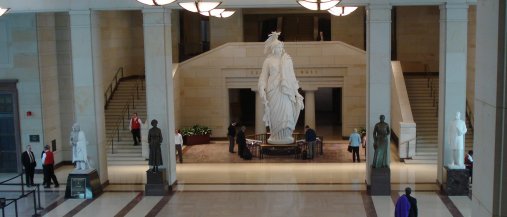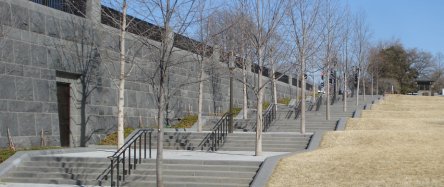Mobile devices, such as cell phones, notebook computers and even hand-held games, may soon be the way most people get their news and information and become their primary way of accessing the Internet. We have to be there too. Some places may bypass conventional computers altogether (much like cellular technology bypassed land-lines), especially as more and more features are added to mobile devices. Cell phones now come bundled with still and/or video cameras, global positioning systems and sophisticated computing capabilities. Mobile devices fundamentally change people’s relationship to information because they are available any time and almost anywhere. Mobile devices allow individuals to report what they see on the spot, along with pictures and connections. User created content has essentially made individuals into media.

Above is the hall of the new visitors’ center at the Capitol. It took them years longer and a lot more money. The guard told me that they had to reinforce all the doors and walls to make them more resilient in case of terrorism. This extra precaution costs us billions, but you gotta have it.
Experts from private industry traded experience with veteran public diplomacy officers when International Information Programs (IIP) and the Foreign Service Institute (FSI) explored innovative and imaginative new ways to leverage mobile technologies for public diplomacy during a conference held at NFATC on February 19.
It quickly became clear that mobile media, despite all the highfalutin hoopla, is just another part of the new media environment. Several of the speakers emphasized the necessity of flexibility in the uncertain and protean world of the new media. The new media is more fluid, fragmented, decentralized and personalized than more traditional media. This creates challenges and opportunities for public diplomacy as well as for the traditional way we deliver messages at State Department.
Hearing the experts at the conference talk about exciting new communications technologies and even more coming soon, it also became clear that changes in new media environment are coming at an accelerating rate. We have already seen some of yesterday’s most promising stars become today’s dinosaurs. There is no reason to think this will be any different tomorrow, so it is silly and to try to pick winners among the new media. Besides, we don’t have to. We have an “all of the above” option. What we have to do is experiment, recognizing that many will fail, but we will learn from the experiments that fail and that even those that succeed will work in unexpected ways requiring flexible responses. The new media allows us to be flexible and being flexible means that we don’t choose “the best.” Instead we try all appropriate methods, choosing the mix of media tools we think will work best for particular tasks. We must use technology but not get beguiled by it, remembering that communication is the destination and the technology merely the vehicle we use to get there. The mix will usually involve the newest technology used in the latest ways, but it will just as often include simple proven techniques such as personal visits. Remember, we have the “all of the above” option. Those are some of the lessons I learned at the conference.
Through all the changes in technologies, Edward R. Murrow’s famous observation remains true, “The really crucial link in the international communication chain is the last three feet, which is bridged by personal contact, one person talking to another.” My colleagues and I at IIP understand that but we also know that we need to use all available and appropriate technologies to get within communication range.

I was happy to be able to attend this conference on mobile communications and proud that IIP is looking forward to the future, as demonstrated by its organizing this sort of meeting. State Department is indeed using a variety of media to carry out its public diplomacy. My colleagues at IIP are using twitter, Facebook, webchats, webcasts, podcasts, Youtube, digital video, blogs, online gaming and various mobile technologies to complement our more traditional Internet, speakers, outreach and publications. Colleagues in other parts of State Department are also making innovations that harness the talents of State’s professionals. It is an exciting time to work in public diplomacy.
